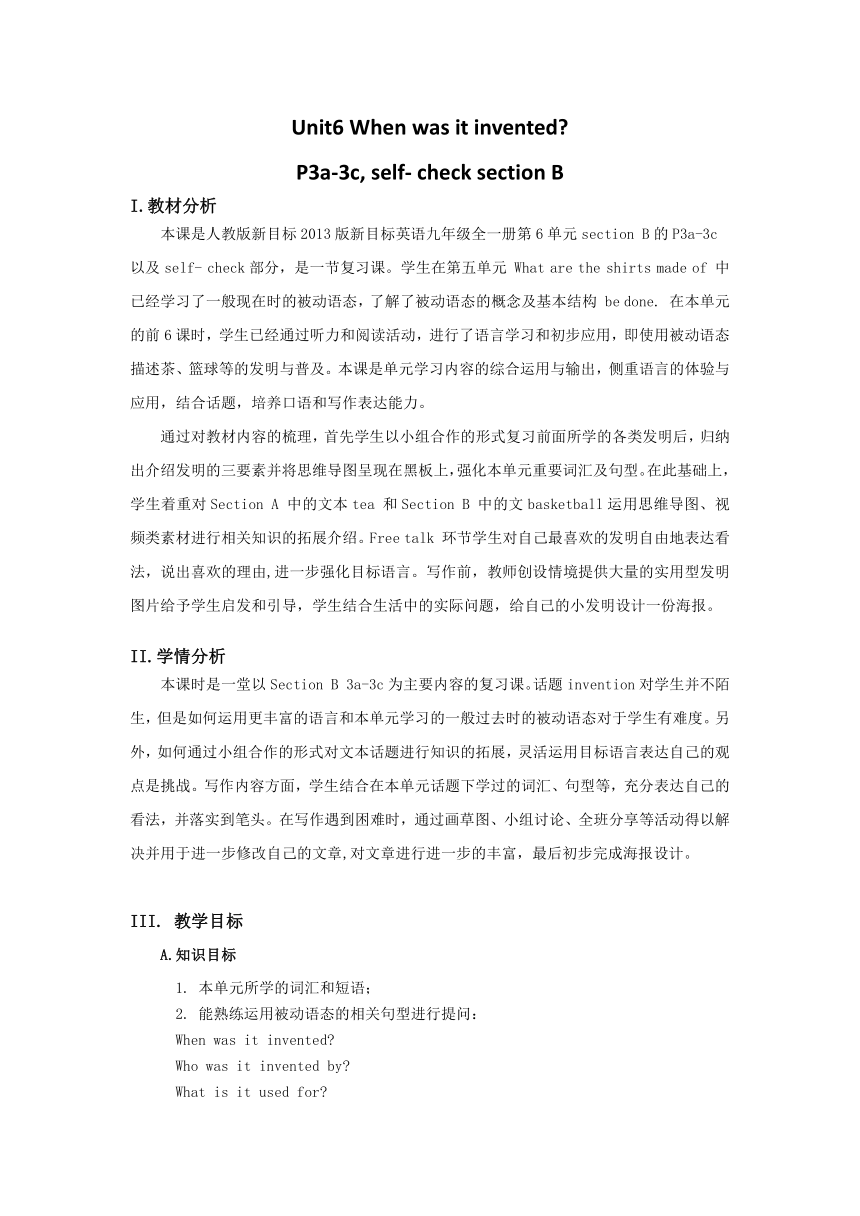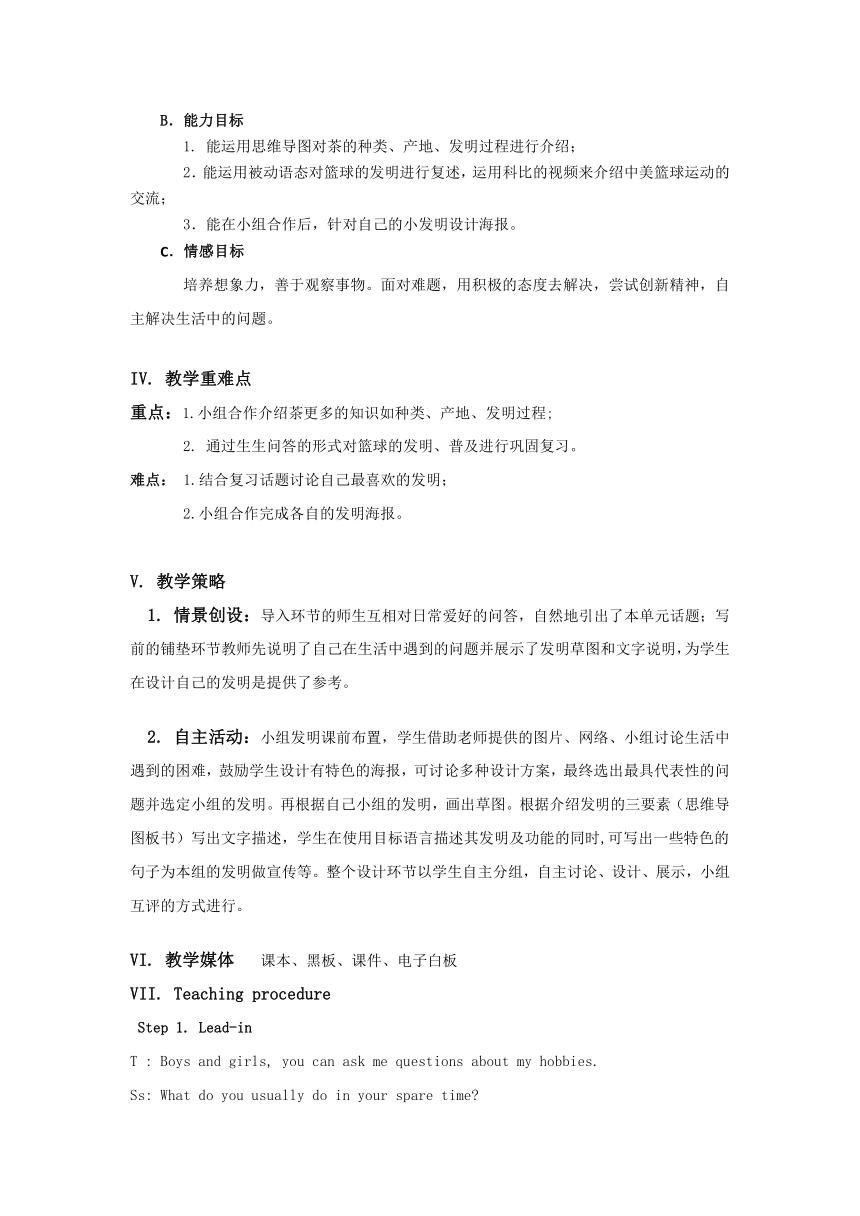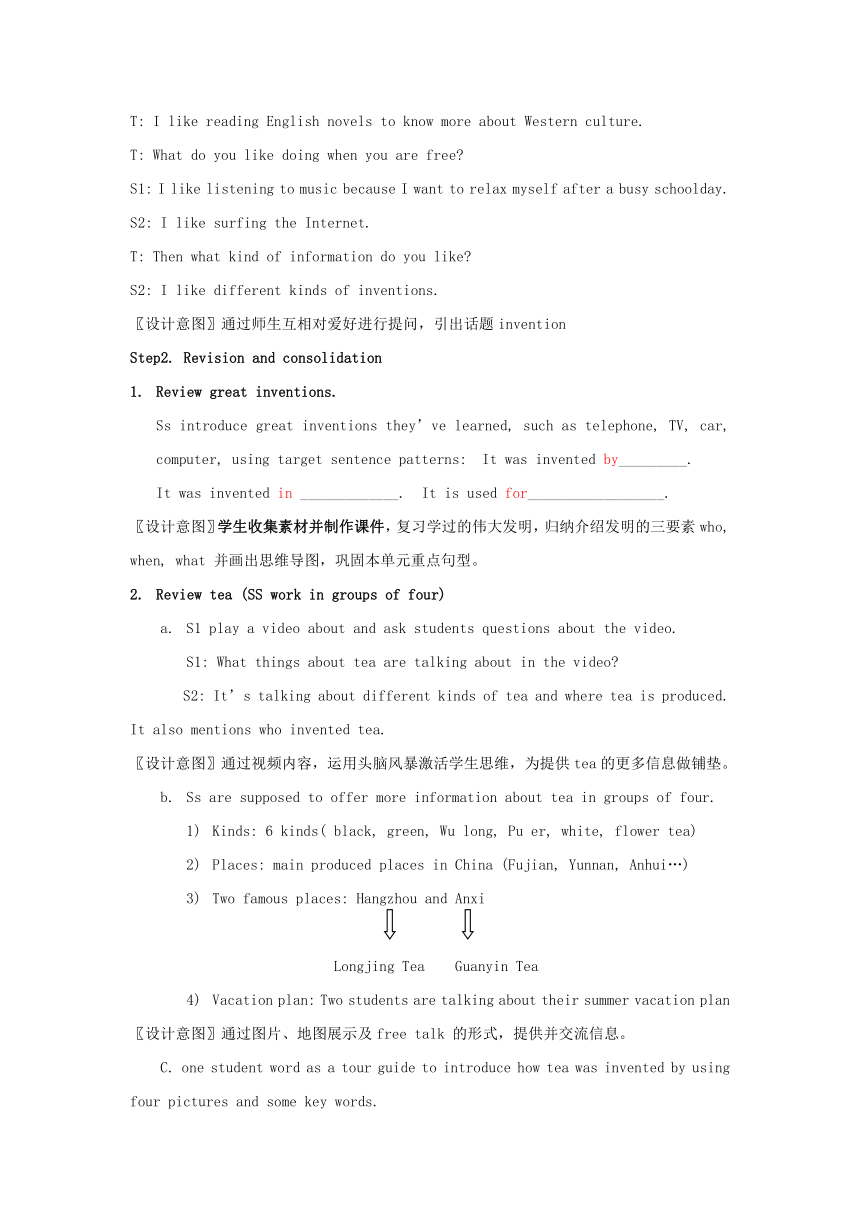人教版九年级全册英语Unit 6 When was it invented?SectionB 3a-3b Self check 教案
文档属性
| 名称 | 人教版九年级全册英语Unit 6 When was it invented?SectionB 3a-3b Self check 教案 |

|
|
| 格式 | doc | ||
| 文件大小 | 1.2MB | ||
| 资源类型 | 教案 | ||
| 版本资源 | 人教新目标(Go for it)版 | ||
| 科目 | 英语 | ||
| 更新时间 | 2022-11-08 09:56:01 | ||
图片预览



文档简介
Unit6 When was it invented
P3a-3c, self- check section B
I.教材分析
本课是人教版新目标2013版新目标英语九年级全一册第6单元section B的P3a-3c以及self- check部分,是一节复习课。学生在第五单元 What are the shirts made of 中已经学习了一般现在时的被动语态,了解了被动语态的概念及基本结构 be done. 在本单元的前6课时,学生已经通过听力和阅读活动,进行了语言学习和初步应用,即使用被动语态描述茶、篮球等的发明与普及。本课是单元学习内容的综合运用与输出,侧重语言的体验与应用,结合话题,培养口语和写作表达能力。
通过对教材内容的梳理,首先学生以小组合作的形式复习前面所学的各类发明后,归纳出介绍发明的三要素并将思维导图呈现在黑板上,强化本单元重要词汇及句型。在此基础上,学生着重对Section A 中的文本tea 和Section B 中的文basketball运用思维导图、视频类素材进行相关知识的拓展介绍。Free talk 环节学生对自己最喜欢的发明自由地表达看法,说出喜欢的理由,进一步强化目标语言。写作前,教师创设情境提供大量的实用型发明图片给予学生启发和引导,学生结合生活中的实际问题,给自己的小发明设计一份海报。
II.学情分析
本课时是一堂以Section B 3a-3c为主要内容的复习课。话题invention对学生并不陌生,但是如何运用更丰富的语言和本单元学习的一般过去时的被动语态对于学生有难度。另外,如何通过小组合作的形式对文本话题进行知识的拓展,灵活运用目标语言表达自己的观点是挑战。写作内容方面,学生结合在本单元话题下学过的词汇、句型等,充分表达自己的看法,并落实到笔头。在写作遇到困难时,通过画草图、小组讨论、全班分享等活动得以解决并用于进一步修改自己的文章,对文章进行进一步的丰富,最后初步完成海报设计。
III. 教学目标
A.知识目标
1. 本单元所学的词汇和短语;
2. 能熟练运用被动语态的相关句型进行提问:
When was it invented
Who was it invented by
What is it used for
B.能力目标
1. 能运用思维导图对茶的种类、产地、发明过程进行介绍;
2.能运用被动语态对篮球的发明进行复述,运用科比的视频来介绍中美篮球运动的交流;
3.能在小组合作后,针对自己的小发明设计海报。
C.情感目标
培养想象力,善于观察事物。面对难题,用积极的态度去解决,尝试创新精神,自主解决生活中的问题。
IV. 教学重难点
重点:1.小组合作介绍茶更多的知识如种类、产地、发明过程;
2. 通过生生问答的形式对篮球的发明、普及进行巩固复习。
难点: 1.结合复习话题讨论自己最喜欢的发明;
2.小组合作完成各自的发明海报。
V. 教学策略
1. 情景创设:导入环节的师生互相对日常爱好的问答,自然地引出了本单元话题;写前的铺垫环节教师先说明了自己在生活中遇到的问题并展示了发明草图和文字说明,为学生在设计自己的发明是提供了参考。
2. 自主活动:小组发明课前布置,学生借助老师提供的图片、网络、小组讨论生活中遇到的困难,鼓励学生设计有特色的海报,可讨论多种设计方案,最终选出最具代表性的问题并选定小组的发明。再根据自己小组的发明,画出草图。根据介绍发明的三要素(思维导图板书)写出文字描述,学生在使用目标语言描述其发明及功能的同时,可写出一些特色的句子为本组的发明做宣传等。整个设计环节以学生自主分组,自主讨论、设计、展示,小组互评的方式进行。
VI. 教学媒体 课本、黑板、课件、电子白板
VII. Teaching procedure
Step 1. Lead-in
T : Boys and girls, you can ask me questions about my hobbies.
Ss: What do you usually do in your spare time
T: I like reading English novels to know more about Western culture.
T: What do you like doing when you are free
S1: I like listening to music because I want to relax myself after a busy schoolday.
S2: I like surfing the Internet.
T: Then what kind of information do you like
S2: I like different kinds of inventions.
〖设计意图〗通过师生互相对爱好进行提问,引出话题invention
Step2. Revision and consolidation
1. Review great inventions.
Ss introduce great inventions they’ve learned, such as telephone, TV, car, computer, using target sentence patterns: It was invented by_________.
It was invented in _____________. It is used for__________________.
〖设计意图〗学生收集素材并制作课件,复习学过的伟大发明,归纳介绍发明的三要素who, when, what 并画出思维导图,巩固本单元重点句型。
2. Review tea (SS work in groups of four)
a. S1 play a video about and ask students questions about the video.
S1: What things about tea are talking about in the video
S2: It’s talking about different kinds of tea and where tea is produced. It also mentions who invented tea.
〖设计意图〗通过视频内容,运用头脑风暴激活学生思维,为提供tea的更多信息做铺垫。
1) Ss are supposed to offer more information about tea in groups of four.
2) Kinds: 6 kinds( black, green, Wu long, Pu er, white, flower tea)
3) Places: main produced places in China (Fujian, Yunnan, Anhui…)
4) Two famous places: Hangzhou and Anxi
Longjing Tea Guanyin Tea
5) Vacation plan: Two students are talking about their summer vacation plan
〖设计意图〗通过图片、地图展示及free talk 的形式,提供并交流信息。
C. one student word as a tour guide to introduce how tea was invented by using four pictures and some key words.
〖设计意图〗创设情景,学生扮演导游角色,运用图片和关键词对茶的发明做介绍,对文本具体信息进行复述。
3. review basketball
a. T: I know a famous person called Kobe Byrant. He likes drinking tea. Do you know him What other things does he like doing
Ss: Playing basketball.
T: I know some of you like playing basketball and you are in our school basketball team.
Two students are in the team and they are invited to offer more information about basketball.
〖设计意图〗创设真实情景,校篮球队的两名队员通过生生问答的方式复习篮球的相关知识。
b. One student ask questions (by using the mind map), the individual student answer questions about how basketball was invented.
〖设计意图〗一名学生利用思维导图向全班提问,巩固篮球的发明以及如何打篮球的相关知识。将文中的思维导图重新设计,既能抓住学生的注意力,也训练学生抓关键词的能力。
C. The other student answers his classmates’ questions to talk about his basketball hero and the communication between Chinese teenagers and American basketball players. Play a video about Kobe’s advice to Chinese young adults in Shanghai.
〖设计意图〗另一名学生展示图片和视频,回答他人提出的问题。向学生们传达中美篮球运动员的交流日益频繁,并且倡导真正的偶像应是哪些能时刻在精神上鼓励你实现梦想的人。
信息技术应用:在茶和篮球的复习环节,学生们课前借助网络寻找图片、地图和视频,并根据文本设计思维导图进行问答,充分发挥了学生的主动性。
Step3. Free talk
Ss talk about their favorite invention individually.
〖设计意图〗学生在文本话题复习后,对自己最喜欢的发明自由地表达看法,说出喜欢的理由。学生畅所欲言,理由合理即可。
Step4. Writing
1. pre-writing have a Discussion
T show photos of several interesting and useful inventions to activate students’ thinking. Talk about two or three pictures what they are used for.
〖设计意图〗展示大量的发明图片,激活学生的思维,为学生能够畅想出自己的发明做铺垫。引导学生对两到三种有趣的发明用途作描述,为自己的写作开拓思路。
2. Design a poster of the invention
T ask Ss to work in groups of four, discuss their common problems in daily lives first. Then draw a draft of their invention and design a poster for it.
〖设计意图〗 小组合作,分工完成任务,为自己的发明设计海报。
3. Show the poster
Ss work as a group and are invited to the front of the classroom to illustrate their invention to the whole class.
〖设计意图〗 小组合作,向全班同学展示海报,阐述发明设计。
信息技术应用:教师利用手机微信,将学生作品上传到白板屏幕上,方便学生进行描述。
4. Vote for the invention
The group leaders give their stars to vote for their favorite invention. The one gets the most votes can be the best invention today.
〖设计意图〗每组推选出组长为最喜欢的发明投票,获得星星最多的即为当日最受欢迎发明。通过此环节,为各小组的活动做出评价。
Step5. Discussion
T show three great inventions (car, computer and atomic bomb) and Ss are encouraged to talk about how they like these pictures.→ They have advantages and disadvantages. We regard them as good inventions as long as we put them to good use.
〖设计意图〗讨论汽车、电脑、原子弹的发明,引导学生深入思考:对于有些发明我们要辩证地看待,我们要尽力发挥它们正面的作用。
板书设计
by in for
Inventor
…
What
When
Who
Invention
P3a-3c, self- check section B
I.教材分析
本课是人教版新目标2013版新目标英语九年级全一册第6单元section B的P3a-3c以及self- check部分,是一节复习课。学生在第五单元 What are the shirts made of 中已经学习了一般现在时的被动语态,了解了被动语态的概念及基本结构 be done. 在本单元的前6课时,学生已经通过听力和阅读活动,进行了语言学习和初步应用,即使用被动语态描述茶、篮球等的发明与普及。本课是单元学习内容的综合运用与输出,侧重语言的体验与应用,结合话题,培养口语和写作表达能力。
通过对教材内容的梳理,首先学生以小组合作的形式复习前面所学的各类发明后,归纳出介绍发明的三要素并将思维导图呈现在黑板上,强化本单元重要词汇及句型。在此基础上,学生着重对Section A 中的文本tea 和Section B 中的文basketball运用思维导图、视频类素材进行相关知识的拓展介绍。Free talk 环节学生对自己最喜欢的发明自由地表达看法,说出喜欢的理由,进一步强化目标语言。写作前,教师创设情境提供大量的实用型发明图片给予学生启发和引导,学生结合生活中的实际问题,给自己的小发明设计一份海报。
II.学情分析
本课时是一堂以Section B 3a-3c为主要内容的复习课。话题invention对学生并不陌生,但是如何运用更丰富的语言和本单元学习的一般过去时的被动语态对于学生有难度。另外,如何通过小组合作的形式对文本话题进行知识的拓展,灵活运用目标语言表达自己的观点是挑战。写作内容方面,学生结合在本单元话题下学过的词汇、句型等,充分表达自己的看法,并落实到笔头。在写作遇到困难时,通过画草图、小组讨论、全班分享等活动得以解决并用于进一步修改自己的文章,对文章进行进一步的丰富,最后初步完成海报设计。
III. 教学目标
A.知识目标
1. 本单元所学的词汇和短语;
2. 能熟练运用被动语态的相关句型进行提问:
When was it invented
Who was it invented by
What is it used for
B.能力目标
1. 能运用思维导图对茶的种类、产地、发明过程进行介绍;
2.能运用被动语态对篮球的发明进行复述,运用科比的视频来介绍中美篮球运动的交流;
3.能在小组合作后,针对自己的小发明设计海报。
C.情感目标
培养想象力,善于观察事物。面对难题,用积极的态度去解决,尝试创新精神,自主解决生活中的问题。
IV. 教学重难点
重点:1.小组合作介绍茶更多的知识如种类、产地、发明过程;
2. 通过生生问答的形式对篮球的发明、普及进行巩固复习。
难点: 1.结合复习话题讨论自己最喜欢的发明;
2.小组合作完成各自的发明海报。
V. 教学策略
1. 情景创设:导入环节的师生互相对日常爱好的问答,自然地引出了本单元话题;写前的铺垫环节教师先说明了自己在生活中遇到的问题并展示了发明草图和文字说明,为学生在设计自己的发明是提供了参考。
2. 自主活动:小组发明课前布置,学生借助老师提供的图片、网络、小组讨论生活中遇到的困难,鼓励学生设计有特色的海报,可讨论多种设计方案,最终选出最具代表性的问题并选定小组的发明。再根据自己小组的发明,画出草图。根据介绍发明的三要素(思维导图板书)写出文字描述,学生在使用目标语言描述其发明及功能的同时,可写出一些特色的句子为本组的发明做宣传等。整个设计环节以学生自主分组,自主讨论、设计、展示,小组互评的方式进行。
VI. 教学媒体 课本、黑板、课件、电子白板
VII. Teaching procedure
Step 1. Lead-in
T : Boys and girls, you can ask me questions about my hobbies.
Ss: What do you usually do in your spare time
T: I like reading English novels to know more about Western culture.
T: What do you like doing when you are free
S1: I like listening to music because I want to relax myself after a busy schoolday.
S2: I like surfing the Internet.
T: Then what kind of information do you like
S2: I like different kinds of inventions.
〖设计意图〗通过师生互相对爱好进行提问,引出话题invention
Step2. Revision and consolidation
1. Review great inventions.
Ss introduce great inventions they’ve learned, such as telephone, TV, car, computer, using target sentence patterns: It was invented by_________.
It was invented in _____________. It is used for__________________.
〖设计意图〗学生收集素材并制作课件,复习学过的伟大发明,归纳介绍发明的三要素who, when, what 并画出思维导图,巩固本单元重点句型。
2. Review tea (SS work in groups of four)
a. S1 play a video about and ask students questions about the video.
S1: What things about tea are talking about in the video
S2: It’s talking about different kinds of tea and where tea is produced. It also mentions who invented tea.
〖设计意图〗通过视频内容,运用头脑风暴激活学生思维,为提供tea的更多信息做铺垫。
1) Ss are supposed to offer more information about tea in groups of four.
2) Kinds: 6 kinds( black, green, Wu long, Pu er, white, flower tea)
3) Places: main produced places in China (Fujian, Yunnan, Anhui…)
4) Two famous places: Hangzhou and Anxi
Longjing Tea Guanyin Tea
5) Vacation plan: Two students are talking about their summer vacation plan
〖设计意图〗通过图片、地图展示及free talk 的形式,提供并交流信息。
C. one student word as a tour guide to introduce how tea was invented by using four pictures and some key words.
〖设计意图〗创设情景,学生扮演导游角色,运用图片和关键词对茶的发明做介绍,对文本具体信息进行复述。
3. review basketball
a. T: I know a famous person called Kobe Byrant. He likes drinking tea. Do you know him What other things does he like doing
Ss: Playing basketball.
T: I know some of you like playing basketball and you are in our school basketball team.
Two students are in the team and they are invited to offer more information about basketball.
〖设计意图〗创设真实情景,校篮球队的两名队员通过生生问答的方式复习篮球的相关知识。
b. One student ask questions (by using the mind map), the individual student answer questions about how basketball was invented.
〖设计意图〗一名学生利用思维导图向全班提问,巩固篮球的发明以及如何打篮球的相关知识。将文中的思维导图重新设计,既能抓住学生的注意力,也训练学生抓关键词的能力。
C. The other student answers his classmates’ questions to talk about his basketball hero and the communication between Chinese teenagers and American basketball players. Play a video about Kobe’s advice to Chinese young adults in Shanghai.
〖设计意图〗另一名学生展示图片和视频,回答他人提出的问题。向学生们传达中美篮球运动员的交流日益频繁,并且倡导真正的偶像应是哪些能时刻在精神上鼓励你实现梦想的人。
信息技术应用:在茶和篮球的复习环节,学生们课前借助网络寻找图片、地图和视频,并根据文本设计思维导图进行问答,充分发挥了学生的主动性。
Step3. Free talk
Ss talk about their favorite invention individually.
〖设计意图〗学生在文本话题复习后,对自己最喜欢的发明自由地表达看法,说出喜欢的理由。学生畅所欲言,理由合理即可。
Step4. Writing
1. pre-writing have a Discussion
T show photos of several interesting and useful inventions to activate students’ thinking. Talk about two or three pictures what they are used for.
〖设计意图〗展示大量的发明图片,激活学生的思维,为学生能够畅想出自己的发明做铺垫。引导学生对两到三种有趣的发明用途作描述,为自己的写作开拓思路。
2. Design a poster of the invention
T ask Ss to work in groups of four, discuss their common problems in daily lives first. Then draw a draft of their invention and design a poster for it.
〖设计意图〗 小组合作,分工完成任务,为自己的发明设计海报。
3. Show the poster
Ss work as a group and are invited to the front of the classroom to illustrate their invention to the whole class.
〖设计意图〗 小组合作,向全班同学展示海报,阐述发明设计。
信息技术应用:教师利用手机微信,将学生作品上传到白板屏幕上,方便学生进行描述。
4. Vote for the invention
The group leaders give their stars to vote for their favorite invention. The one gets the most votes can be the best invention today.
〖设计意图〗每组推选出组长为最喜欢的发明投票,获得星星最多的即为当日最受欢迎发明。通过此环节,为各小组的活动做出评价。
Step5. Discussion
T show three great inventions (car, computer and atomic bomb) and Ss are encouraged to talk about how they like these pictures.→ They have advantages and disadvantages. We regard them as good inventions as long as we put them to good use.
〖设计意图〗讨论汽车、电脑、原子弹的发明,引导学生深入思考:对于有些发明我们要辩证地看待,我们要尽力发挥它们正面的作用。
板书设计
by in for
Inventor
…
What
When
Who
Invention
同课章节目录
- Unit 1 How can we become good learners.
- Section A
- Section B
- Unit 2 I think that mooncakes are delicious!
- Section A
- Section B
- Unit 3 Could you please tell me where the restroom
- Section A
- Section B
- Unit 4 I used to be afraid of the dark.
- Section A
- Section B
- Unit 5 What are the shirts made of?
- Section A
- Section B
- Review of Units 1-5
- Unit 6 When was it invented?
- Section A
- Section B
- Unit 7 Teenagers should be allowed to choose their
- Section A
- Section B
- Unit 8 It must belong to Carla.
- Section A
- Section B
- Unit 9 I like music that I can dance to.
- Section A
- Section B
- Unit 10 You're supposed to shake hands.
- Section A
- Section B
- Review of Units 6-10
- Unit 11 Sad movies make me cry.
- Section A
- Section B
- Unit 12 Life is full of the unexpected
- Section A
- Section B
- Unit 13 We're trying to save the earth!
- Section A
- Section B
- Unit 14 I remember meeting all of you in Grade 7.
- Section A
- Section B
- Review of Units 11-14
